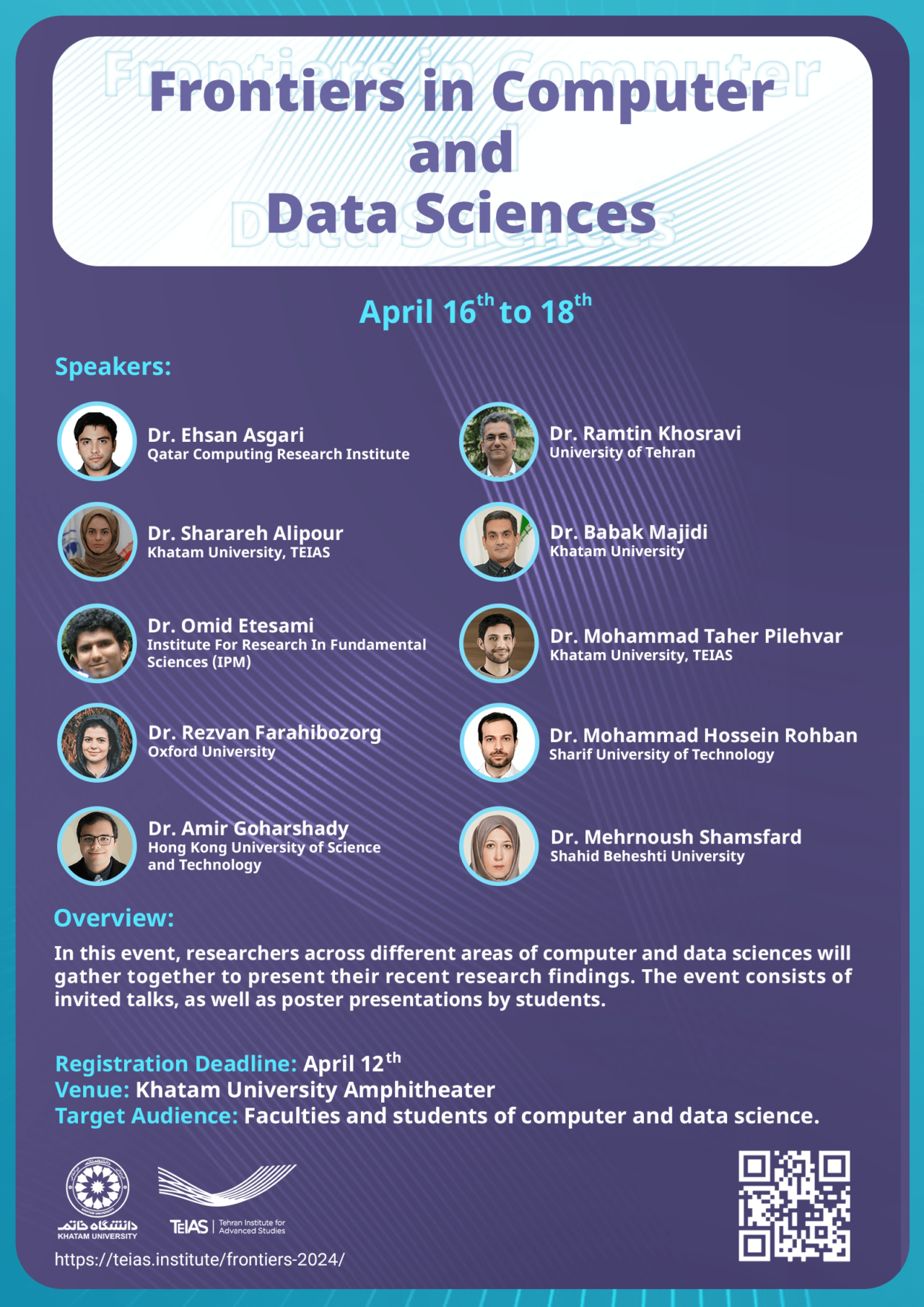
Khatam University Amphitheater
April 12, 2024 (24 Farvardin 1403)
Overview
In this event, researchers across different areas of computer and data sciences will gather together to present their recent research findings. The event consists of invited talks, as well as poster presentations by students.
Target Audience
Faculties and students of computer and data science.
Speakers
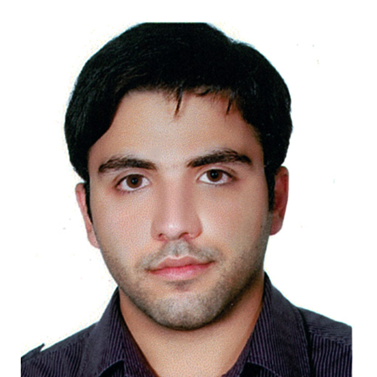
Dr. Ehsan Asgari
Title: Exploring Recent Advances in Iranian Language Processing and Digital Humanities
Abstract:
Language technologies play a crucial role in enabling machines to understand and generate human languages, transforming digital communication, and information access. Language technologies have proven to be invaluable tools for exploring rich literatures and cultural heritages, offering significant potential to address longstanding challenges in the humanities domain. In this talk, we present some of our recent works in developing language technologies for Iranian languages and digital humanities, with a focus on 1) data mining of the Quran and Hadith, 2) the study of Iranian languages, and 3) AI for media-arts, showcasing how these innovations contribute to both technological progress and cultural understanding.

Dr. Sharareh Alipour
Title: Partial Coloring Complex, Vertex Decomposability and Tverberg’s Theorem with Constraints
Abstract:
We present a novel family of simplicial complexes associated with the graph coloring problem. They include many well-known simplicial complexes such as chessboard complexes. We then study conditions under which these complexes become vertex decomposable and hence shellable. The connectivity of these complexes is also investigated. We apply these results to Tverberg’s theorem with constraints. Notably, we prove a conjecture of Engstro ̈m and Nor ́en on Tverberg graphs.
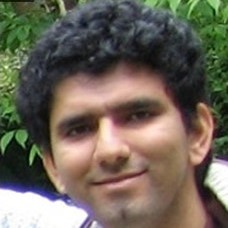
Dr. Omid Etesami
Title: High-dimensional algorithmic optimal transport
Abstract:
Optimal transport is the problem of moving a mass of objects from an initial mass distribution to a final mass distribution with minimum cost. The input to the problem is the initial and final distributions, as well as the distance metric or cost of transportation between each initial position and each final position. We should match points in the initial mass with points in the final mass so as to minimize the total cost. This problem was first proposed in the context of economics and recently in the context of machine learning to compare and transform probability distributions.
We will explain a new method for computing transportations between distributions in high dimensions. This approach is different from previous works in that it does not assume that the distributions are given explicitly. Rather, it assumes that we can just query or sample the distribution (through what is often called an oracle in the computer science literature.) This allows the method to work for inputs that may be exponentially larger than explicitly given inputs. The simple main technique behind our method is to change the components in the initial vector point one by one and as little as possible, while making sure we attain the final distribution. Our method can be turned into a specific algorithm for some parameterized classes of distributions and distance metrics. For each class, our method only guarantees that the transportation cost is not worse than the optimal transport of a worst-case instance among that class up to a constant multiplicative factor. We also mention the relationship of this work with previous work on computational concentration of measure, which appeared in the context of adversarial machine learning.
Based on ongoing work with Salman Beigi, Amir Najafi, and Mohammad Mahmoody.
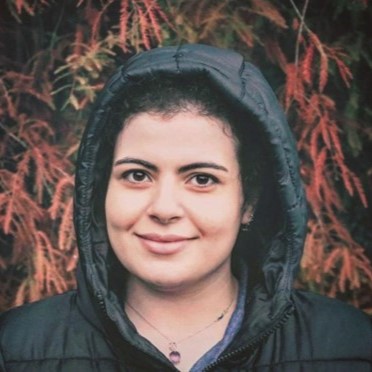
Dr. Rezvan Farahibozorg
Title: Next Generation Machine Learning Techniques for Brain Function Mapping
Abstract:
Functional brain imaging from large populations, as e.g., made available by the UK Biobank with expected 100,000 participants, provides unprecedented resources to examine the brain at population-scale. This holds great promise for addressing fundamental questions in brain health: how differences in brain function result in individual variability in cognition and brain disorders? To leverage this potential, we need new machine learning techniques that can scale to these data and extract accurate, meaningful, clinically relevant characteristics for populations and individuals. In this talk, I will first present an overview of the latest advances in this field. I will then provide details of our proposed framework, Probabilistic Functional Modes, which uses hierarchical Bayesian models to model the brain function in big populations and individuals simultaneously. I will show the model’s utility for: a) capturing cross-individual variability in brain function; b) capturing multiscale information processing in the brain; c) making predictions about individualistic traits. I will finally present an overview of some of the outstanding challenges and future directions in this field.
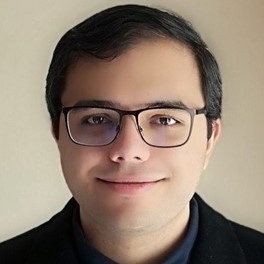
Dr. Amir Goharshady
Title: Scalable Program Analysis via Parameterization
Abstract:
Many classical tasks in compiler optimization, program analysis and formal verification are formalized in terms of graph problems, usually over the control-flow or call graphs of programs. Examples include data-flow analyses (such as null-pointer and reaching definitions), register allocation, and the entire framework of algebraic program analysis (APA). The resulting graph problems often end up being NP-hard. Even when a PTIME solution exists, it is not usually linear-time and fails to scale up to handle modern software systems with hundreds of millions of lines of code.
As it turns out, control-flow and call graphs of programs are often sparse and exhibit certain desirable structures, such as tree-likeness, which can be exploited to obtain much faster algorithms for these classical tasks. In this talk, we formalize the sparsity of graphs arising in programs in terms of treewidth, pathwidth and treedepth and present new bounds and algorithms that scale lightweight formal methods to billions of lines of code.

Dr. Ramtin Khosravi
Title: Efficient Construction of Family-Based Behavioral Models
Abstract:
Family-based behavioral models capture the behavior of a software product line in a single model, incorporating the variability among the products. Constructing such a model is sometimes a result of merging the behavioral models of individual products, which may be obtained from a model learning process. To make this construction more efficient, one may improve the efficiency of model learning and/or the merging of the models. In this presentation, we give a brief overview on our previous results on how to make model learning faster, and have a deeper discussion on our more recent work on how to merge product models into a family-based model more efficiently. An important step in model merging is to identify which pair of states from different models are similar enough to be merged. We show that computing similarity of the state pairs based on local information improves efficiency while keeping the merged model reasonable.
Ramtin Khosravi is an assistant professor at the School of ECE, University of Tehran. His research interests are mainly in modeling, verification, and testing of asynchronous distributed systems and modeling and analysis of software product lines. He has been active in the software development industry for 20 years in several domains such as automotive industry, eLearning, and financial domains. He received his Ph.D. in 2005 from Sharif University of Technology.
The talk will be co-presented with Shaghayegh Tavassoli
Bio of co-speaker: Shaghayegh Tavassoli is a Ph.D. candidate in Software Engineering at the School of ECE, University of Tehran. Her research interests are model learning and constructing the behavioral models of software product lines. She is also an invited lecturer at the University of Tehran.

Dr. Babak Majidi
Title: Data Science of Digital Twin Earth
Abstract:
In the next few decades, the impact of human activities amplified by climate change will create significant challenges for various Earth ecosystems. These challenges will produce negative feedback loops which intensify the stress on biodiversity and natural habitats as well as endangering critical resources such as food, fresh water, healthy air and livable areas for humans. Descriptive, predictive and prescriptive modeling of the Earth sub-systems as well as the impact of human activities on these systems can provide solutions to address these environmental challenges. Digital Twin of Earth is one of the methods to address these challenges by visualizing, monitoring and forecasting natural systems and human activities on Earth. This presentation provides an introduction to methods for modeling Earth sub-systems using data science and machine learning. The discussed frameworks and models can help researchers to provide intelligent solutions for smart agriculture, food security, water resource management, air pollution management as well as regenerative solutions for improving natural ecosystems.
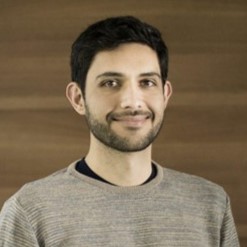
Dr. Mohammad Taher Pilehvar
Khatam University, TEIAS
Title: Interpreting Transformer Decisions
Abstract:
Deep learning models, often perceived as inscrutable black boxes, offer predictions without insights into their decision-making processes. This talk addresses the critical need for model interpretability, providing an overview of some of the recent techniques designed to shed light on how these models arrive at their conclusions. I will specifically delve into recent advancements in backward and forward methods for evaluating token attribution and context mixing, with a particular emphasis on Transformer models due to their prevalent role in current deep learning research. This exploration not only aims to demystify the operational intricacies of Transformers but also to highlight the importance of transparency in the development and deployment of AI systems.
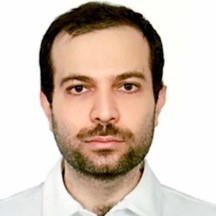
Dr. Mohammad Hossein Rohban
Title: Robust Out-of-distribution Detection
Abstract:
Out-of-distribution (OOD) detection refers to the problem of identifying samples that significantly differ from training samples at inference. Recently, several effective methods have been suggested to solve this problem in the area of Computer Vision. However, such methods are typically fragile when they face imperceptible adversarial perturbations in their inputs. This issue would cause a violation of their purpose, which was to enhance trustworthiness through input monitoring and rejection of OOD samples that the model might not produce a valid response for. Here, we aim to address this problem through a well known technique called Outlier Exposure, which is to utilize samples believed to be OOD during training. We show, both theoretically and empirically, that such samples need to satisfy certain conditions to be effective for this purpose: 1. Near-distribution (training OOD samples be close to the normal samples); 2. OOD samples diversity; 3. Semantic deviation of OOD samples from the normal ones. We leverage simple text-to-image models along with a text description of normal samples to generate training OOD samples that adhere to the mentioned criteria. When trained with regular adversarial training, the proposed OOD detection method exhibits significantly improved robustness against strong adversarial attacks. We showcase method performance against a wide diversity of datasets in Computer Vision, demonstrating its generality and universality.
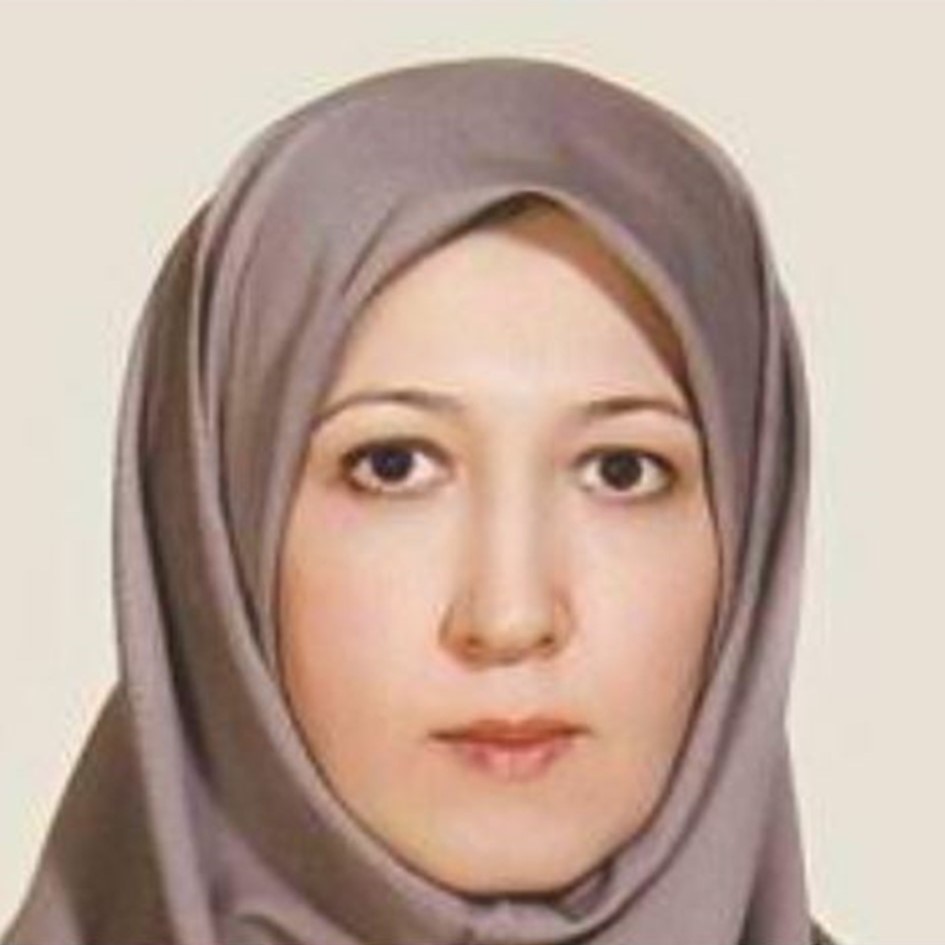
Dr. Mehrnoush Shamsfard
Shahid Beheshti University
Title: Evaluating Large Language Models
Abstract:
The emergence of large language Models (LLMs) has revolutionized natural language processing (NLP) applications cross various domains. The widespread adoption of these models necessitates a thorough understanding of their capabilities and limitations. However, assessing their performance and capabilities presents a myriad of challenges. In this talk, we delve into the intricate process of evaluating language models from various perspectives and will explore the diverse metrics, benchmarks, and methodologies employed. From traditional measures like perplexity and accuracy to more nuanced evaluations such as fluency and coherence, hallucination and bias, knowledge and reasoning capabilities and considering the ethical implications and societal impact. We will then have a look at the evaluation results of some English LLMs and talk about available Persian LLMs and their elementary evaluation results.
Dr. Mehrnoush Shamsfard has received her BS and MSc both on computer software engineering from Sharif University of Technology and her PhD in Computer Engineering- Artificial Intelligence from AmirKabir University of Technology, Tehran, Iran.
She has been with Shahid Beheshti University from 2004. She is currently associate professor of Faculty of computer science and engineering, and also the head of NLP research Laboratory of this faculty. Her main fields of interest are natural language processing with special focus on the Persian language, evaluating NLP resources and products, developing intelligent assistants and chatbots, knowledge engineering (ontologies and knowledge graphs), text mining and semantic and intelligent web.
Schedule
18:00-18:15 … Online opening
18:15-19:00 … Talk: Dr Goharshady (online)
19:15-20:00 … Talk: Dr Pilevar (online)
08:15-08:45 … Reception and light refreshment
08:45-09:00 … Opening
09:00-09:45 … Talk: Dr Khosravi & Tavassoli
09:45-10:15 … Tea / coffee break.
10:15-11:00 … Talk: Dr Etesami (1)
11:00-11:15 … Tea / coffee break.
11:15-12:00 … Talk: Dr Etesami (2)
12:30-13:30 … Lunch
13:30-14:15 … Talk: Dr Asgari
14:15-14:30 … Tea / coffee break.
14:30-16:30 … Poster presentations
08:30-09:00 … Light refreshment
09:00-09:45 … Talk: Dr Rohban
09:45-10:00 … Tea / coffee break.
10:00-10:45 … Talk: Dr Shamsfard
10:45-11:00 … Tea / coffee break.
11:15-12:00 … Talk Dr Alipour
12:30-13:30 … Lunch
13:30-14:15 … Talk: Dr Majidi
14:15-14:30 … Tea / coffee break.
14:30-15:15 … Talk: Dr Farahibozorg (online)
15:30-16:30 … Final ceremony (with poster awards)
